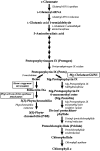Signal transduction between the chloroplast and the nucleus
- PMID: 12045286
- PMCID: PMC151264
- DOI: 10.1105/tpc.010446
Signal transduction between the chloroplast and the nucleus
Figures



References
-
- Allen, J.F. (1992). Protein phosphorylation in regulation of photosynthesis. Biochim. Biophys. Acta 1098 275–335. - PubMed
-
- Asamizu, E., Sato, S., Kaneko, T., Nakamura, Y., Kotani, H., Miyajima, N., and Tabata, S. (1998). Structural analysis of Arabidopsis thaliana chromosome 5. VIII. Sequence features of the regions of 1,081,958 bp covered by seventeen physically assigned P1 and TAC clones. DNA Res. 5 379–391. - PubMed
-
- Barak, S., Nejidat, A., Heimer, Y., and Volokita, M. (2001). Transcriptional and post-transcriptional regulation of the glycolate oxidase gene in tobacco seedlings. Plant Mol. Biol. 45 399–407. - PubMed
-
- Bauer, C.E., Elsen, S., and Bird, T.H. (1999). Mechanisms for redox control of gene expression. Annu. Rev. Microbiol. 53 495–523. - PubMed
-
- Beale, S.I. (1999). Enzymes of chlorophyll synthesis. Photosynth. Res. 60 43–73.
Publication types
MeSH terms
Substances
Grants and funding
LinkOut - more resources
Full Text Sources

